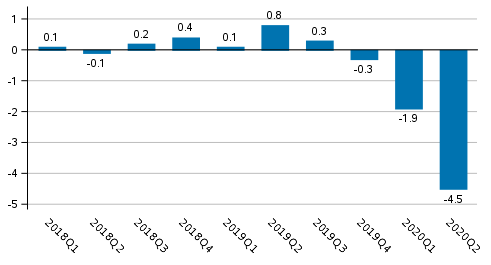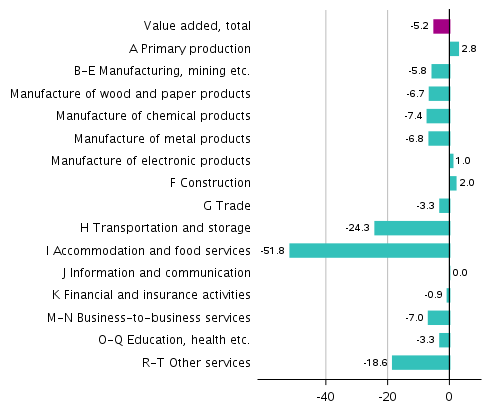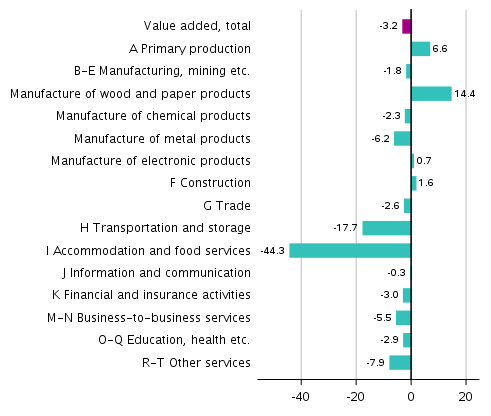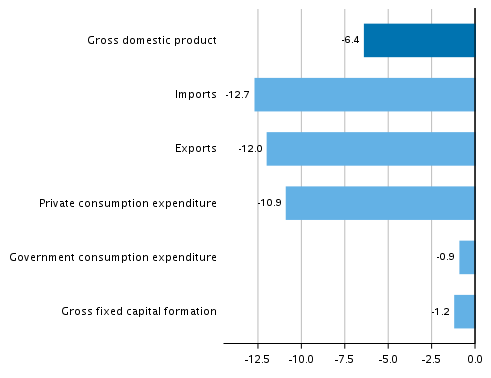Finland's downturn deepened in April to June, exports and consumption contracted considerably
In the April to June period, the seasonally adjusted volume of Finland’s gross domestic product diminished by 4.5 per cent from the previous quarter. GDP adjusted for working days went down by 6.4 per cent compared to the second quarter of 2019. Examined at current prices, gross domestic product adjusted for working days was 4.9 per cent lower than one year ago.
Figure 1. Volume change of GDP from the previous quarter, seasonally adjusted, per cent

According to preliminary data compiled by Eurostat, gross domestic product in the EU area contracted by as much as 11.7 per cent in the second quarter from the previous quarter and by 14.1 per cent from one year back.
Output
The volume of total value added generated by all industries decreased by 3.2 per cent from the previous quarter and by 5.2 per cent from twelve months back.
Figure 2. Changes in the volume of value added generated by industries in the second quarter of 2020 compared to one year ago, working-day adjusted, per cent

Figure 3. Changes in the volume of value added generated by industries in the second quarter of 2020 to the previous quarter, seasonally adjusted, per cent

Value added in primary production, that is, agriculture, forestry and fishery grew in April to June. Agriculture increased by as much as 22 per cent from one year ago. Compared to the quiet first quarter, forestry grew but remained on a lower level than last year.
Output in manufacturing industries (incl. mining and quarrying and energy supply, water supply and waste management) decreased in the second quarter. The forest industry grew briskly from the previous quarter, which was weak partly due to the labour dispute. The metal and chemical industries contracted. Construction and particularly civil engineering grew from one year back.
The volume of service industries contracted by six per cent from the level of the second quarter of 2019, and the corona crisis affects particularly service industries: Transport contracted by 24 per cent from one year ago, value added in accommodation and food service activities remained at around one half compared with last year's April to June and in business service activities the volume contracted by seven per cent from one year ago. Motor vehicle trade decreased by 15 per cent but the volume of retail trade grew by four per cent in April to June from a year earlier. Measurement of the volume of health care services involves particular uncertainty, because the measures normally taken in the industry were postponed and labour input and other resources were reserved for the treatment of the corona pandemic.
Imports, exports, consumption and investments
Total demand contracted by 7.5 per cent in April to June from one year back. International trade and private consumption decreased strongly, and investments and government consumption expenditure did not grow either.
Figure 4. Changes in the volume of main supply and demand items in the second quarter of 2020 compared to one year ago, working-day adjusted, per cent

Figure 5. Changes in the volume of main supply and demand items in the second quarter of 2020 compared to the previous quarter, seasonally adjusted, per cent

In April to June, the volume of exports contracted by nine per cent and that of imports by 10 per cent from the previous quarter. Compared to the second quarter of 2019, exports of goods went down by four per cent and exports of services by 28 per cent. Imports of goods decreased by 10 per cent and those of services by 18 per cent. As a result of falling prices, the current priced values of international trade in goods decreased even more: exports of goods declined by 11 per cent in euros and imports of goods by 19 per cent from the previous year.
Private consumption decreased in the second quarter by seven per cent from the previous quarter. Households' consumption expenditure on semi-durable consumer goods (e.g. footwear, clothing) decreased by 18 per cent and on services by 15 per cent from the April to June 2019 level. Government consumption expenditure decreased by one per cent both from the previous quarter and from one year ago.
Gross fixed capital formation, or investments, fell by half a per cent from the previous quarter and by one per cent from the year before. Public investments grew by seven per cent, but private investments fell by three per cent compared to the second quarter of 2019. Investments in machinery, equipment and transport equipment decreased by 14 per cent. Investments in residential buildings, non-residential buildings and civil engineering increased.
Employment, wages and salaries and national income
In April to June the number of employed persons fell by 3.2 per cent and that of hours worked by 6.2 per cent from one year back.
According to Statistics Finland’s Labour Force Survey, the rate of unemployment for the April to June period was 8.9 per cent, while in last year’s corresponding period it was 7.7 per cent.
In the April to June period, the nominal wages and salaries bill of the national economy decreased by 3.6 per cent from the previous quarter and by 4.8 per cent year-on-year. Social contributions paid by employers decreased by 5.5 per cent from one year back.
The operating surplus (net), which in business bookkeeping corresponds roughly with operating profit, grew in the second quarter by 3.4 per cent from twelve months back. Gross national income calculated at current prices was 1.3 per cent lower than one year previously.
The available data
These preliminary quarterly data are based on the source information on economic development that had become available by 21 August 2020. The annual level data for 1990 to 2019 correspond with the National Accounts data released on 18 June 2020, except for those on the rest of the world sector (imports, exports, primary income from/to the rest of the world), which may have become revised. More detailed data for 2019 will be published on 18 September 2020, when the quarterly accounts database tables will also be updated.
Data concerning the third quarter of 2020 will be released on 27 November 2020. A flash estimate on GDP development for July to September will be released in connection with the Trend Indicator of Output on 13 November 2020.
Due to the benchmarking and seasonal adjustment methods, quarterly data may become slightly revised in connection with each release. However, the largest revisions take place during the two to three years following the release on a quarter, because final annual accounts data are published at a lag of around two years from the end of the statistical reference year. Seasonally adjusted and trend time series always become revised against new observations irrespective of whether the original time series becomes revised or not.
The quality description is available on Statistics Finland's website: http://www.tilastokeskus.fi/til/ntp/laa.html .
Methodological description of Quarterly National Accounts.Source: National Accounts 2020, 2nd quarter. Statistics Finland
Inquiries: Samu Hakala 029 551 3756, Antti Kosunen 029 551 3613, kansantalous.suhdanteet@stat.fi
Director in charge: Jan Nokkala
Updated 28.8.2020
Official Statistics of Finland (OSF):
Quarterly national accounts [e-publication].
ISSN=1797-9765. 2nd quarter 2020,
Finland's downturn deepened in April to June, exports and consumption contracted considerably
. Helsinki: Statistics Finland [referred: 8.1.2026].
Access method: http://stat.fi/til/ntp/2020/02/ntp_2020_02_2020-08-28_kat_001_en.html

